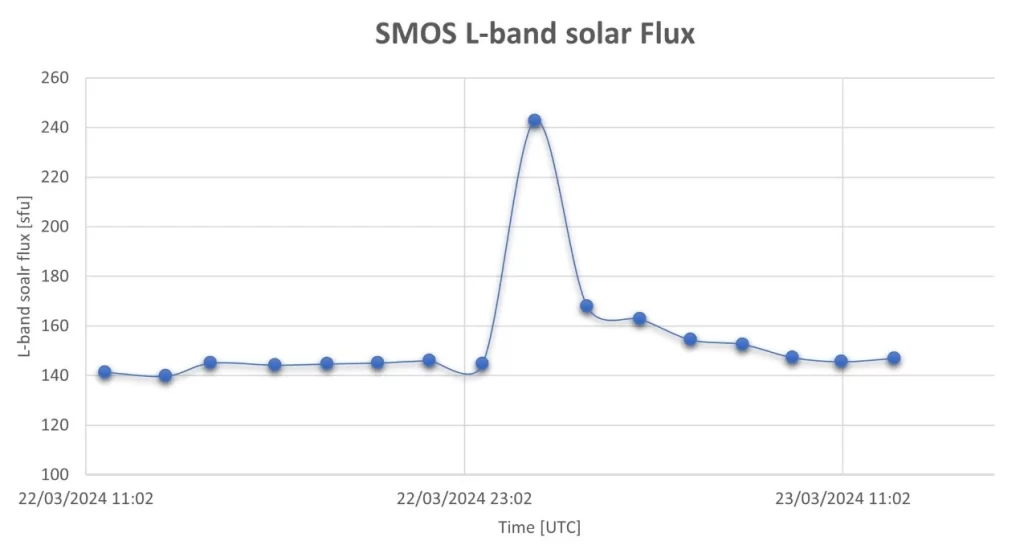The European Space Agency’s SMOS and Swarm satellites have, for the first time, successfully tracked a severe solar storm, following an X1.1 solar flare and a halo coronal mass ejection (CME) on March 23, 2024. The CME impacted Earth on March 24, producing a G4 – Severe geomagnetic storm — the strongest geomagnetic storm since September 2017.
Upon reaching Earth at approximately 15:00 UTC on March 24, the CME produced G3 – Strong and then G4 – Severe geomagnetic storming, substantially earlier than anticipated.
This event marked the most intense geomagnetic storm observed since September 2017, significantly affecting Earth’s magnetic field. The rapid onset and severity of the storm provided an unprecedented opportunity for ESA’s SMOS and Swarm missions, to demonstrate their capabilities in real-time observation of such events.
The Swarm satellite constellation, specifically designed to monitor Earth’s magnetic field, was ideally positioned to capture the storm’s effects. Each of the three Swarm satellites is equipped with a magnetometer, allowing for precise measurements of magnetic field strength and variations.
These instruments were crucial in tracking the changes caused by the geomagnetic storm, with Swarm Alpha being the first to report significant alterations in the magnetic field. Following closely, Swarm Bravo offered additional data, indicating extensive changes at lower latitudes, which are uncommon during such events.
Simultaneously, ESA’s SMOS satellite, primarily focused on measuring soil moisture and ocean salinity via its Miras interferometer radiometer, unexpectedly played a role in monitoring the solar storm. SMOS’s ability to detect L-band radio waves emitted by the Sun during solar flares allowed it to capture the solar radio burst associated with the March 23 flare.
Typically, these signals would be considered noise in SMOS’s primary observational duties. However, in the context of space weather monitoring, they provided valuable data on the flare’s impact on global navigation satellite systems (GNSS), flight radar, and L-band communications. This near-real-time monitoring capability was crucial in diagnosing disruptions, such as a notable incident in December 2023 where satellites lost GPS connectivity due to solar activity.


The collaboration between SMOS and Swarm in this event showed the adaptability and extended capabilities of ESA’s Earth Explorer missions beyond their initial scopes. Their combined observations offer a comprehensive view of solar storm effects, from the solar emissions to their impact on Earth’s magnetic field, enhancing our understanding of space weather dynamics.
This event’s monitoring is particularly relevant as the Sun approaches its solar maximum, anticipated in 2025. During this phase, increased solar activity, including more frequent and intense solar flares, is expected. The advanced warning and observational capabilities of SMOS and Swarm provide invaluable insights into the interactions between solar phenomena and Earth’s environment, contributing to improved preparedness for space weather events.
Space weather monitoring is a key role of ESA’s Space Safety Programme, an initiative set to receive a significant boost from the upcoming Vigil mission. Slated for a 2031 launch, Vigil aims to enhance our capabilities in detecting and preparing for solar phenomena by observing the Sun’s side not visible from Earth.
This ‘first of its kind’ mission will identify areas of potentially hazardous solar activity well before they pose a direct threat to our planet.
Offering around-the-clock operational data from deep space for the first time, Vigil will extend the advance warning period for critical space weather effects from the current 12 – 18 hours to an impressive four to five days, significantly improving our preparedness for solar events that could lead to destructive geomagnetic storms and providing a broader understanding of the potential challenges we may face.
References:
1 SMOS and Swarm team up to spot huge solar storm – ESA – March 26, 2024
2 Major, long-duration X1.1 solar flare produces Earth-directed CME – The Watchers – March 24, 2024
Featured image credit: ESA/E Qamili (stillshot)
Decade of Swarm satellite data unveils new insights into Earth’s magnetic field and core dynamics
Tuesday, March 26, 2024
ESA’s SWARM investigates weakening of Earth’s magnetic field, possible split up of South Atlantic Anomaly
Wednesday, May 20, 2020
Birkeland currents stronger in the northern hemisphere, vary with the season
Thursday, March 23, 2017
Supersonic plasma jets discovered
Thursday, March 23, 2017
Highest resolution map of Earth’s lithospheric magnetic field
Tuesday, March 21, 2017
Swarm-B on possible collision course with space debris
Tuesday, January 24, 2017
Accelerating high-latitude jet stream discovered in Earth’s core
Tuesday, December 20, 2016



